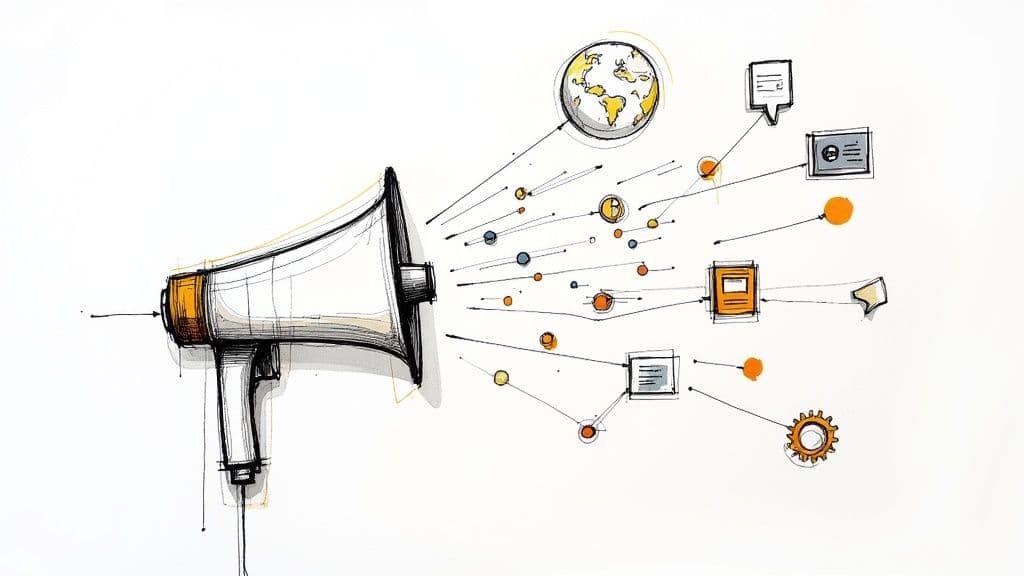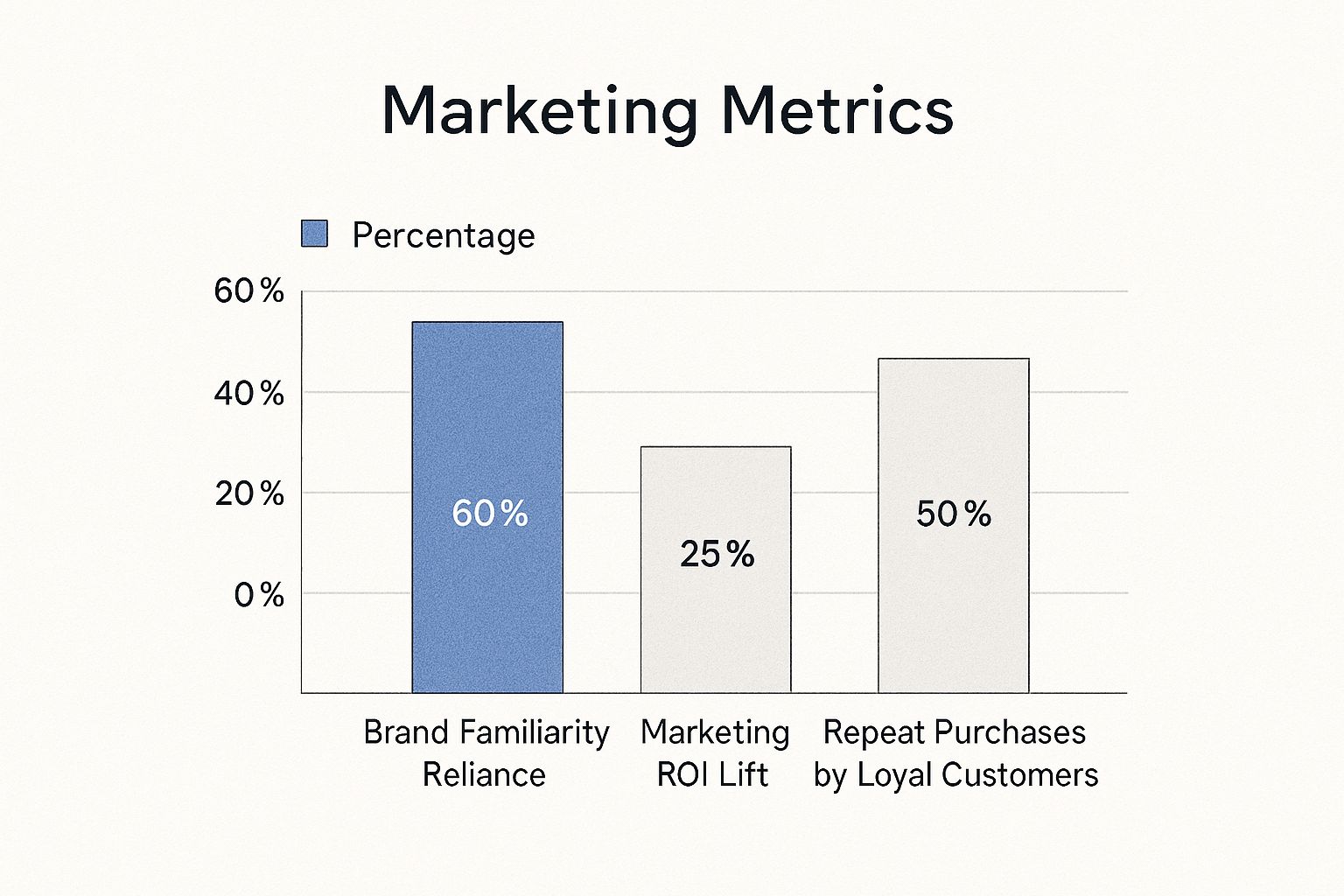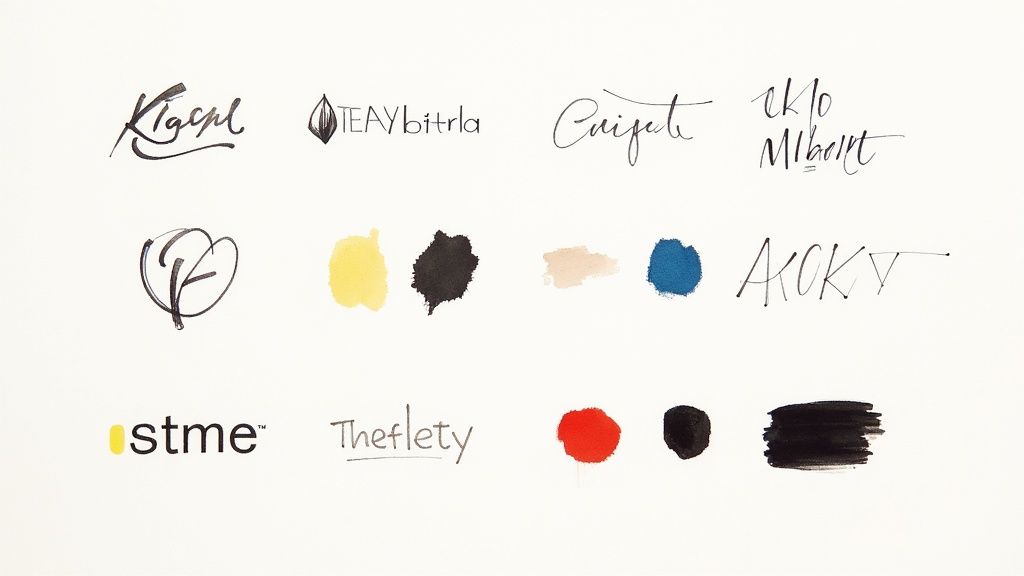How to Build Brand Awareness That Actually Works
October 9, 2025

Building brand awareness isn't about just one thing. It's a mix of creating a solid brand identity and then getting it out there through great content, genuine community engagement, and smart public relations. The real goal is to build trust and recognition by consistently being where your audience is, so your brand isn’t just seen—it’s remembered.
Beyond Buzzwords: Why Brand Awareness Matters Now
Let's be real: "brand awareness" can sound like a fluffy, vague marketing term. Everyone nods along and says they want more of it, but pinning down its direct impact on the bottom line can feel a bit fuzzy.
In reality, brand awareness is the foundation of any sustainable growth strategy. Think of it as the invisible engine that makes all your other marketing efforts—from a Facebook ad to a cold call—run smoother and more efficiently.
When someone recognizes your brand, they're not just seeing a logo. They're recalling experiences, feelings, and a promise of quality. This familiarity is a powerful mental shortcut. In a sea of options, people naturally drift toward what they know and trust, giving you a huge leg up before a potential customer even starts comparing features or prices.
The Foundation of Customer Trust and Loyalty
At its core, building brand awareness is really about building relationships at scale. It’s about creating a presence that feels both reliable and authoritative.
This is non-negotiable, especially when you consider that a staggering 81% of consumers say they need to trust a brand before they even think about buying from them. On top of that, 50% are more likely to purchase from a brand they recognize. Visuals play a massive role here, too, since 55% of first impressions are visual. If you want to dive deeper, you can explore more brand awareness insights to see the data behind the strategy.
This chart really drives home the tangible benefits of investing in brand awareness, from boosting marketing efficiency to fostering rock-solid customer loyalty.

The numbers don't lie. Brand familiarity doesn't just help you attract new customers; it's absolutely essential for keeping them around and getting more out of every marketing dollar you spend.
Moving from Recognition to Reputation
A strong brand does more than just get noticed; it builds a reputation that works for you around the clock. When people trust your brand, they’re far more likely to:
- Choose you over competitors: Even if your price is a bit higher, the feeling of safety that comes with a known brand often seals the deal.
- Become repeat customers: Loyalty is born from trust, and brand awareness is the first handshake in that relationship.
- Advocate for your business: Happy customers who know and love your brand become your best marketers through word-of-mouth.
Building awareness isn't about shouting the loudest. It's about being the most consistent, helpful, and memorable voice in your industry. It transforms your business from a simple commodity into a trusted resource.
So, by focusing on how to build brand awareness, you're not just chasing vanity metrics. You're making a long-term investment in brand equity—a powerful asset that makes customer acquisition easier, increases customer lifetime value, and builds a loyal community that will cheer you on.
Defining Your Brand’s Voice and Visuals

Before you can really get your name out there, you need a brand people will remember. This goes way beyond just having a slick logo. A powerful brand identity is the whole package—it's the way you sound, the way you look, and the feeling people get every single time they interact with your business.
Think of this identity as your brand's North Star. It's the guide for every piece of content you write, every social media update you post, and every press release you send out. Get it right, and your brand feels cohesive and memorable. Without it, your efforts can come across as scattered and, frankly, forgettable.
Crafting an Authentic Brand Voice
Your brand voice is essentially your company's personality. To make it stick, it has to be authentic. Are you the witty, informal friend like Wendy's on social media, or are you the trusted, authoritative expert like IBM? Finding the right voice makes your audience feel like they're connecting with a real person, not just a faceless company.
The first step is always to get inside the heads of your audience. What do they care about? What kind of language do they use? Matching your tone to their expectations is how you start building a real, genuine connection.
You can think about your voice in terms of common archetypes:
- The Sage: Your goal is to share wisdom and expertise. Think Google or Harvard Business Review.
- The Jester: You’re here to entertain and bring a little joy. Old Spice’s famously quirky campaigns are a masterclass in this.
- The Everyman: You’re relatable, friendly, and completely down-to-earth. Brands like IKEA use this voice to feel approachable and honest.
Once you’ve landed on a direction, write it down. A simple style guide that spells out your tone, key messages, and even specific words to avoid is a game-changer. It gets everyone, from your marketing team to your customer service reps, speaking the same language.
A brand voice isn't just what you say, but how you say it. It’s the consistent thread that runs through your website copy, emails, and social media, making your brand instantly recognizable by words alone.
Consistency here has a real impact on your bottom line. Companies with consistent branding see revenue jump by 10-20%. And yet, only about 30% of brands have clear guidelines that are actually used. When you also consider that 47% of global consumers prefer buying from locally owned companies, the power of a relatable identity becomes crystal clear. You can dig into more must-know branding statistics to see just how much consistency drives growth.
Designing a Memorable Visual Identity
If your voice gives your brand its personality, your visual identity is what creates that crucial first impression. We’re visual creatures, after all. Elements like your logo, color palette, and fonts all work together to create a lasting mental shortcut to your brand.
Just think about Apple's clean, minimalist aesthetic or Coca-Cola's iconic red-and-white script. These visual cues are so strong they’re recognized worldwide without a single word. That’s the ultimate goal—a visual system that’s distinct, memorable, and versatile enough to work everywhere, from a billboard to a tiny favicon. For a dose of inspiration, check out these powerful examples of compelling digital narratives.
A strong visual identity is more than just a logo. It’s a complete system, usually documented in a brand identity kit, that ensures you look polished and consistent everywhere you show up.
Here's a breakdown of what a solid brand identity kit should contain. Think of it as your single source of truth for all things visual.
Key Elements of a Brand Identity Kit
| Component | Purpose | Key Considerations |
|---|---|---|
| Logo Suite | Provides the primary logo and variations (e.g., horizontal, icon-only) for different use cases. | Make sure it’s scalable, readable at all sizes, and looks great in color and monochrome. |
| Color Palette | Evokes specific emotions and creates visual harmony across all of your materials. | Define primary, secondary, and accent colors with their exact hex codes. |
| Typography | Establishes a clear visual hierarchy and makes your content easy to read. | Choose a primary headline font and a secondary body font that are legible on both web and print. |
| Imagery Style | Guides the selection of photos, illustrations, and icons that match your brand’s personality. | Define the overall mood (e.g., bright and optimistic vs. professional and serious) and subject matter. |
By taking the time to carefully define both your voice and visuals, you’re doing more than just creating a pretty package. You’re building a predictable, trustworthy experience that becomes the foundation for building real, lasting brand awareness.
Creating Content That Builds Your Reputation

A memorable brand identity might get your foot in the door, but it's high-quality content that invites people inside and convinces them to stay. Content is how you prove your expertise, build trust, and show your value long before ever asking for a sale. In many ways, it's the engine that powers modern brand awareness.
Forget about just churning out generic blog posts to keep your site "fresh." The real goal is to become the go-to resource in your niche. When a potential customer has a question, your brand should be the first one they think of because they know you provide clear, helpful, and authoritative answers.
This approach shifts your marketing from a sales pitch into a genuine service. You're not just selling something; you're providing solutions and building a reputation for being genuinely helpful. This is the cornerstone of brand awareness that actually lasts.
Develop Foundational Pillar Content
Here’s a secret I've learned over the years: a sustainable content strategy isn't about creating more content—it's about creating smarter content. You start with what’s known as pillar content. These are massive, in-depth pieces that cover a core topic in your industry from top to bottom.
Think of a pillar piece as the definitive guide on a subject your audience deeply cares about. It’s the kind of resource they’ll bookmark, share with their team, and come back to again and again.
Some of the most effective formats I've seen for pillar content include:
- Ultimate Guides: A comprehensive, multi-chapter article that explores a broad topic in extreme detail. A fintech company, for example, might create "The Ultimate Guide to Angel Investing for First-Time Founders."
- Original Research Reports: Run a survey, analyze industry data, and publish your unique findings. This stuff is gold because it’s unique to your brand and immediately positions you as a thought leader.
- In-Depth Case Studies: Go way beyond a simple testimonial. Create a detailed story showing how you solved a complex problem for a client, complete with real data and tangible results.
A single piece of pillar content becomes a goldmine. It’s not just one blog post; it’s the source material for dozens of smaller content assets.
Repurpose Everything to Maximize Reach
Once that strong pillar piece is live, the real work begins. The next step is to break it down and repurpose it across every channel you're on. This is how you get the most mileage out of your initial effort, making sure your core message reaches people no matter how they prefer to get their information.
For instance, that "Ultimate Guide" can be sliced and diced into:
- Multiple Blog Posts: Each chapter can easily become its own standalone article.
- Social Media Posts: Pull out key statistics, compelling quotes, and actionable tips for LinkedIn, X, or Instagram.
- A Video Series: Film short, digestible videos explaining each key concept from the guide.
- An Infographic: Visualize the most important data points and processes in a shareable graphic.
- A Webinar or Presentation: Host a live event where you walk your audience through the guide's main takeaways.
This strategy ensures your message is consistently reinforced at every touchpoint. It also respects your audience's time by delivering valuable information in the format that works best for them. A well-executed content strategy is especially crucial for specialized fields; for a closer look, you might be interested in our guide on content marketing for tech companies.
A pillar content strategy isn't about working harder; it's about working smarter. By investing heavily in one foundational piece, you create an entire ecosystem of content that consistently builds brand awareness and authority over time.
Find Topics Your Audience Actually Cares About
Even the most beautifully crafted content in the world will fall completely flat if nobody is looking for it. Effective content creation always starts with understanding your audience’s pain points, questions, and curiosities. Your job is to intercept their needs with the perfect answer.
To uncover these topics, you need to do a bit of digging. The best way is to start listening to the conversations already happening out there.
- Keyword Research Tools: Fire up tools like Semrush or Ahrefs to see the exact questions people are typing into Google related to your field.
- Community Forums: Dive into sites like Reddit, Quora, or industry-specific forums. This is where you'll find the unfiltered questions and challenges your target audience discusses every day.
- Talk to Your Customers: Your sales and customer support teams are on the front lines. Ask them what questions they hear over and over again. They're sitting on a treasure trove of content ideas.
By grounding your content strategy in real-world problems, you ensure every piece you create is immediately relevant and valuable. This builds a powerful sense of trust and makes your brand synonymous with helpful information—which is the ultimate goal of building brand awareness.
Building a Community on Social Media

If great content is the foundation, social media is where your brand actually comes to life. It’s no longer just a digital billboard for shouting about promotions; it’s a place for genuine connection. When you figure out how to build brand awareness on social media, you stop collecting followers and start cultivating a community of true advocates.
The trick is to treat it like a real conversation, not a monologue. A smart social strategy isn't about being on every single platform. It’s about being present and active on the few platforms where your ideal customers are already hanging out.
Choose Your Platforms Wisely
One of the most common mistakes I see is brands spreading themselves too thin. This inevitably leads to burnout and mediocre results across the board. Instead of jumping on every new app, focus your energy where it’s going to make a real difference. Each platform has its own personality, culture, and audience expectations.
Think about where your brand’s voice and visuals will feel most at home. A B2B SaaS company will probably get more traction sharing insightful articles on LinkedIn, while a fashion brand will absolutely thrive on the visual-first world of Instagram and TikTok.
Social media success isn’t measured by the number of platforms you’re on, but by the depth of the connections you build. Choose your channels with intention and commit to showing up consistently and authentically for your community.
For example, if you're a fintech startup trying to reach millennials, you could develop a powerful combo: a witty, educational presence on X (formerly Twitter) paired with engaging, bite-sized explainer videos on Instagram Reels. The goal is always to meet your audience where they are, in a way that feels completely natural.
Spark Conversations and Encourage Engagement
Okay, so you've picked your platforms. Now the real work begins. The algorithms reward engagement, so your main job is to create content that people actually want to interact with. That means moving way beyond just posting product updates.
Ask open-ended questions that get your audience talking about their own experiences. Run polls to get their feedback on new ideas or just to start a fun debate. And when someone takes the time to comment, respond thoughtfully. These small interactions prove there’s a real person behind the logo who is actually listening.
A few tactics I’ve found incredibly effective for getting people to engage:
- Host "Ask Me Anything" (AMA) Sessions: Get your founder or a resident expert to answer questions live. This is a fantastic way to humanize your brand and deliver serious value.
- Create Interactive Quizzes: Use Instagram Stories or a tool like Typeform to build fun quizzes related to your industry. People love to test their knowledge and share their results.
- Reply with Personality: When it makes sense, reply to comments with a relevant GIF, meme, or even a quick video. It makes the interaction far more memorable than just plain text.
This kind of active engagement is what transforms passive followers into a real community. You’re creating a space where people feel heard, which is the first step toward building genuine brand loyalty.
Turn Followers into Brand Advocates
The ultimate goal here is to empower your audience to become your best marketers. User-generated content (UGC) is the gold standard. It’s authentic, powerful social proof that’s way more convincing than any ad you could ever run.
Encourage your customers to share photos or videos of them using your product. You could run a contest with a branded hashtag or simply feature the best customer content on your feed (always ask for permission first!). When you put your customers in the spotlight, they feel seen and appreciated, which deepens their connection to your brand.
Another killer strategy is to collaborate with creators and influencers who already have the trust of your target audience. This isn't about paying for a generic shoutout; it’s about building real partnerships with creators whose values align with yours.
Think of a sustainable skincare brand partnering with a micro-influencer who champions eco-friendly living. Their authentic endorsement can introduce your brand to a highly engaged and relevant audience, feeling less like an ad and more like a trusted recommendation from a friend.
Earning Credibility with Media Mentions
While great content and a lively social media presence build a direct line to your customers, nothing establishes trust quite like a stamp of approval from an outside source. When a respected journalist or publication features your brand, it sends a powerful signal to the market. This is about more than just exposure; it’s about earning validation you simply can't buy.
This is the world of public relations, or PR—the art of securing this kind of earned media. It's a cornerstone strategy for building brand awareness because one well-placed article can introduce your business to thousands of ideal customers. Better yet, that introduction comes with an implied endorsement that paid advertising can never match.
Finding the Right Journalists to Pitch
Let’s get one thing straight: the days of blasting a generic press release to a massive, impersonal list are long gone. That's a surefire way to land in the spam folder and burn potential relationships. Today, successful PR is all about precision and a personal touch.
Your mission is to find the specific writers who live and breathe your industry—and whose readers are your future customers.
Start by figuring out where your target audience already spends their time. Are they glued to tech blogs, thumbing through trade journals, or following columnists in major newspapers? Once you’ve got a list of publications, you can zero in on the right people.
- Do your homework. Don't just grab a name. Read their last five articles to get a real feel for their beat, their tone, and the kinds of stories that get them excited.
- Connect on social media. Many journalists are active on platforms like X (formerly Twitter) or LinkedIn. Following them offers a real-time window into their interests and current projects.
- Use smart tools. A solid media database can be a lifesaver. Tools like these help you pinpoint journalists by topic, publication, or recent coverage, saving you countless hours of digging.
This research phase is absolutely critical. Pitching a story that’s completely off-base for a journalist is the fastest way to get ignored, now and in the future.
Crafting a Pitch They Actually Want to Read
Journalists are drowning in emails, often sifting through hundreds of pitches every single day. Yours has to cut through the noise by being instantly relevant and genuinely helpful. A great pitch isn't really about you at all; it’s about giving the journalist a fantastic story for their audience.
Keep your email short and sweet. Your subject line should be a compelling headline for the story itself, not just an announcement about your company. In the body, quickly explain why the story is timely, interesting, and a perfect match for their readers.
Pro Tip: Your pitch needs to frame your news as a story, not a promotion. It has to immediately answer the journalist's unspoken question: "Why should my readers care?"
To make your pitch truly compelling, be sure to include:
- A Sharp Story Angle: What’s the hook? Is it surprising new data? An inspiring customer story? A controversial take on an industry trend?
- The Bare Essentials: Briefly say who you are, but keep the focus squarely on the story you're offering.
- An Offer of Value: Make their job easier. Offer up an expert for an interview, provide exclusive data, or include a link to high-quality photos.
The goal is to hand them a story on a silver platter. The more you can package it for them, the better your odds of getting a reply.
Streamlining Your Outreach with Automation
Trying to manage all of this manually—finding contacts, personalizing emails, tracking follow-ups—can get out of hand fast. This is where modern PR tools come in, dramatically improving your ability to build brand awareness through media relations. For a deeper dive, check out our guide on the fundamentals of media relations.
Here’s a look at the PressBeat dashboard, which helps companies organize their entire outreach process.
Platforms like PressBeat let you automate the repetitive tasks without losing that all-important personal touch. You can build highly targeted media lists, send customized pitches at scale, and see how your campaigns are performing, all in one place. This frees you up to focus on what really moves the needle: building real, lasting relationships with the journalists who can share your story with the world.
Got Questions About Building Brand Awareness? Let's Dig In.
As you get into the weeds of building brand awareness, you're bound to have some questions. It’s a big undertaking with a lot of moving parts, and knowing how to handle the common hurdles can make or break your strategy. So, let’s clear up a few of the most common uncertainties I see from marketers and founders.
Think of this as your quick-reference guide. We'll tackle the big questions about timelines, how to actually measure this stuff, and where brand awareness fits into your bigger marketing picture. Getting these answers straight will help you set goals that make sense and make smarter moves as you grow.
How Long Does It Take to Build Brand Awareness?
This is usually the first thing everyone wants to know. The honest answer? Building real, lasting brand awareness is a marathon, not a sprint. It’s a long-term investment in your brand’s reputation and recognition, not some overnight hack.
If you stick to a focused and consistent strategy, you can start to feel some initial traction and see a noticeable bump in recognition within 6 to 12 months. This is the phase where you’re laying the groundwork—nailing down your messaging, keeping your social channels buzzing, and pushing out a steady stream of valuable content.
But getting to that top-of-mind status, where you're the first name customers think of? That often takes several years of dedicated effort. The real key here is consistency. Showing up for your audience, day in and day out, across all your channels is what builds the trust and familiarity that defines a powerful brand.
How Can I Measure Brand Awareness?
Measuring brand awareness can feel a bit like trying to bottle lightning, but it doesn't have to be. While there’s no single, simple formula, you can track a mix of metrics that, together, paint a very clear picture of your brand's growing footprint.
A fantastic place to start is your website’s direct traffic. When people type your URL straight into their browser, it’s a powerful sign that they know who you are. This is one of the purest indicators of brand recall you can get.
Beyond that, you need to be looking at a blend of different data points:
- Social Media Buzz: Don't just count followers. Look at shares, comments, and mentions. These are the conversations that show your brand is actually resonating with people.
- Brand Mentions: Use tools to keep an eye out for when your brand gets talked about online, even when there's no link back to you. A rise in these "unlinked mentions" means your name is getting out there.
- Branded Search Volume: Pop into your Google Search Console and see how many people are searching specifically for your company or product names. A steady climb here is a killer sign that awareness is growing.
The only way to truly measure brand awareness is to look at a collection of indicators. No single metric will give you the full story, but together, they’ll show you whether your hard work is actually paying off in how well your audience knows and remembers you.
For a more direct approach, try running simple brand surveys. Just asking new customers "How did you hear about us?" can give you incredibly valuable feedback on which of your channels are really doing the heavy lifting.
What Is the Difference Between Brand Awareness and Lead Generation?
Getting this distinction right is crucial for setting clear marketing goals. They’re absolutely related and need each other to work, but they play very different roles in the customer’s journey.
Brand awareness is all top-of-funnel. The whole point is to get your target audience familiar with your brand, what you do, and what you’re all about. You’re building recognition and trust long before anyone is even thinking about making a purchase.
Lead generation, on the other hand, is a middle-of-funnel play. This is where you focus on turning that awareness and interest into an actual, tangible connection. It’s the process of capturing a potential customer's information—think an email address from a webinar sign-up or a contact form submission.
Here's a simple way to think about it:
- Awareness is when someone scrolls past your insightful post on LinkedIn and thinks, "Wow, this company really gets it."
- Lead generation is when they click the link in that post to download your free ebook and give you their email in return.
Here's the kicker: strong brand awareness makes lead generation way easier and cheaper. When someone already knows and trusts your brand, they're far more likely to take that next step and hand over their contact info.
Ready to get your story in front of the right journalists and build serious brand credibility? PressBeat automates your press outreach with AI-powered precision, connecting your brand with influential media outlets. Start your campaign today.